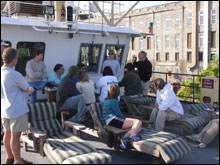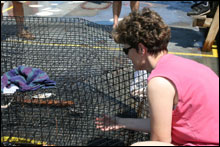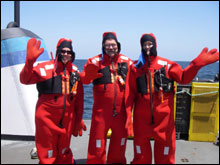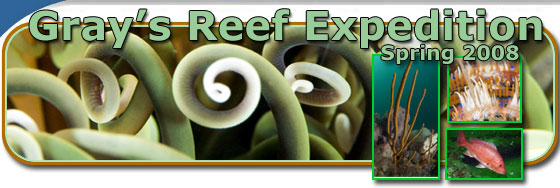Error processing SSI file
|
Mission Log: May 13, 2008
NOAA Ship Nancy Foster
By Sarah Fangman and Cathy Sakas
We’re off for the second half of our mission, which promises to be an incredibly busy week at sea! Our team of thirteen scientists/educators gathered last night to load our gear on board, get familiar with the ship and settle in for departure. Prior to leaving the dock we had a series of briefings to make sure we all understood the objectives of the cruise and what each of our roles would be. Who knew that going to sea involves so many meetings? Dive meetings, science meetings, safety meetings, education meetings… we thought we left the office to avoid all that! The hope is that all those meetings will pay off in terms of productivity underway.
 |
|
Principal Investigators Sarah Fangman and Greg McFall brief the science and education teams on the "steel beach" as the NOAA Ship Nancy Foster departs their Savannah River dockage.
|
The trip out to Gray’s Reef National Marine Sanctuary takes about five hours, and during that time, the team continued to ready for operations. Our education team demonstrated their can-do attitude and willingness to jump in and help by taking responsibility for getting the bait ready for the traps we’ll be using to attempt to catch gag, scamp and red snapper for tagging. We’re using menhaden as bait, which is a very oily and smelly fish. Fortunately the smell did not deter Katherine, Beth and Steve, who spent time sorting out how to secure the bait in the trap. The goal was to attract fish, but not allow the bait to get eaten in the first few minutes after deployment (if the bait gets eaten quickly, there is no incentive to draw the fish we hope to catch into the trap). Our experience suggests that small fish such as black sea bass (Centropristis striatus) and tomtate (Haemulon aurolineatum) will enter the trap very shortly after it hits the sea floor. We do not want them to eat up all the bait before the fish we are targeting enter the trap. We also do not want the small fish to get caught in the trap, so during the last leg, Dave Grenda and Jim Stansell cut small holes in the traps to allow the little fish to escape unharmed.
 |
|
Beth McGovern puts the finishing touches on baiting the chevron. Afterwards she did a fish dance to ensure that the target fish would go into the trap! We'll take all the help we can get!
|
Once the traps were baited, the ship’s crew helped us get them ready to launch. Greg Walker, the Chief Bosun and Gordon Pringle, the Bosun Group Leader, attached lines with floats on the ends so the ship could return to the traps, capture the line and haul the traps back on board.
With all that taken care of we were finally able to start catching fish! Matt Kendall selected a site within Gray’s Reef for our first trap deployment. He had seen lots of grouper and snapper at this location on a previous dive, so we thought we’d see if we could get any of them into our traps! At three o’clock this afternoon, we deployed two traps. We plan to return tomorrow morning to see if we captured any snapper or grouper that we can tag. Our goal is to place acoustic tags in 42 fish during this mission.
We also spent time today preparing a saltwater holding tank that will be used to keep the fish on board the ship prior to and after surgery. Tom Cleary, the ship’s Second Assistant Engineer, helped connect the ship’s continuously running seawater system to the fish tank and make certain we’d be able to keep the fish as comfortable as possible during their stay on the Foster!
 |
|
Educators Kathryn Kornberg, Steve Desper and Beth McGovern are ready to abandon ship it in their chic, figure flattering "Gumby Suits".
|
As if that wasn’t enough activity for the day, we also conducted safety drills. Fire and abandon ship drills occur every cruise to make sure everyone is ready for any and all emergencies that could happen at sea. Again our education team demonstrated what great sports they were by agreeing to give their “gumby” (survival) suits a test. With a bit of assistance from “the experienced staff” all three educators were able to don their suits in good time and zip up using their big mitts, which is not as easy as it looks or sounds. It makes you wonder how well one would do in an actual emergency if you had to get in one of these suits in a hurry, but then when you have enough incentive such as saving your life you can do just about anything fast!
Because the ship works twenty-four hours a day, our day was not over when the sun set! Our survey team (Missy Partyka, Melanie Ovard, Jimmy Skinner and Andrew Kennedy) will work thru the night to continue mapping the seafloor around Gray’s Reef.
Not a bad day’s work for our first day at sea!
|








